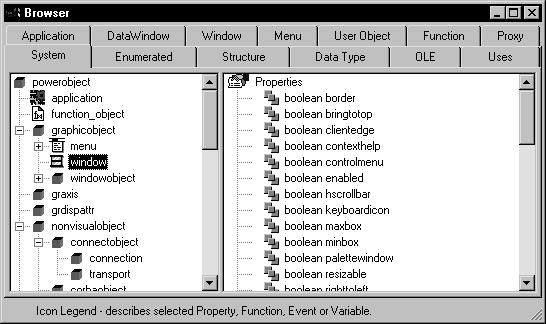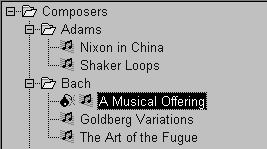You can use TreeView controls in your application to represent relationships among hierarchical data. An example of a TreeView implementation is PocketBuilder’s Browser. The tab pages in the Browser contain TreeView controls.
Figure 11-8: Tree view panes in the PocketBuilder Browser

![]() Smartphone platforms
PocketBuilder application users can use the arrow keys on
the Smartphone to navigate the items in a TreeView control, but
you must program a menu item or soft key to move the focus from
the TreeView to another control in the same main window.
Smartphone platforms
PocketBuilder application users can use the arrow keys on
the Smartphone to navigate the items in a TreeView control, but
you must program a menu item or soft key to move the focus from
the TreeView to another control in the same main window.
A TreeView consists of TreeView items that are associated with one or more pictures. You add images to a TreeView in the same way you add images to a ListView, except that you use the Pictures tab page instead of the Large Picture or Small Picture tab pages.
You can choose from a group of stock images provided by PocketBuilder, or use BMP, GIF, ICO, JPEG, or PNG files for the images that you add to a TreeView. You cannot add a PNG file to a picture control in the PocketBuilder UI, only in script. (PNG files are not supported on the desktop, only on Pocket PC devices and emulators.)
![]() Dynamically changing image size
The image size can be changed during execution by setting
the PictureHeight and PictureWidth properties when you create a
TreeView.
Dynamically changing image size
The image size can be changed during execution by setting
the PictureHeight and PictureWidth properties when you create a
TreeView.
For more information, see “PictureHeight” and “PictureWidth” in the online Help.
![]() To add items to a TreeView:
To add items to a TreeView:
Write a script in the TreeView constructor event to create TreeView items
For more information about populating a TreeView, see the chapter on using lists and tree views in the Resource Guide.
A “state” picture is an image that appears to the left of the TreeView item, indicating that the item is not in its normal mode. A state picture can indicate that a TreeView item is being changed, or that it is performing a process and is unavailable for action.
Figure 11-9: TreeView control showing a state picture

![]() To specify a state picture for a TreeView item:
To specify a state picture for a TreeView item:
Select the TreeView control to display its properties in the Properties view and then select the State tab.
Do one of the following:
Use the StatePictureName drop-down list to select stock pictures to add to the TreeView
Use the Browse button to select a BMP, ICO, GIF, or JPEG file
Working with the rows in the State or Pictures tab page in the Properties view is the same as working with rows in the State, Small Picture, or Large Picture tab pages in a ListView control. For information, see “Using ListView controls”.
![]() To activate a state picture for a TreeView item:
To activate a state picture for a TreeView item:
Write a script that changes the image when appropriate
For example, the following script gets the current TreeView item and displays the state picture for it.
long ll_tvi treeviewitem tvi ll_tvi = tv_foo.finditem(currenttreeitem! , 0) tv_foo.getitem(ll_tvi , tvi) tvi.statepictureindex = 1 tv_foo.setitem(ll_tvi, tvi)
For more information on the TreeView control, see the chapter on using lists and tree views in the Resource Guide.
You can modify other properties of the TreeView control on the tab pages of the control’s Properties view.
![]() To specify other TreeView properties:
To specify other TreeView properties:
Select the TreeView control to display its properties in the Properties view and then select the General tab.
Enter a name for the TreeView in the Name text box and specify other properties as appropriate.
Among the properties you can specify on the General properties page are:
The border style
Whether the TreeView has lines showing the item hierarchy
Whether the TreeView includes collapse and expand buttons
Whether the user can delete items
Whether the user can drag and drop items into the TreeView
For other options, choose the tab appropriate to the property you want to specify:
Choose this tab |
To specify |
|---|---|
Pictures |
The images used to represent TreeView items |
State |
The state images for the TreeView items |
Font |
The font size, family, and color for TreeView items |
Others |
The size and position of the TreeView |
For more information about TreeView properties, right-click in any tab page in the Properties view and select Help from the pop-up menu, or see Objects and Controls in the online Help. Because of differences in the target platform, some of the properties listed for PowerBuilder objects and controls do not apply to PocketBuilder objects and controls.
For more information on the TreeView control, see the chapter on using lists and tree views in the Resource Guide.